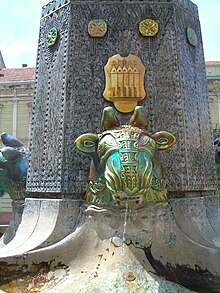
Art Nouveau is an international style of art, architecture, and applied art, especially the decorative arts. It was often inspired by natural forms such as the sinuous curves of plants and flowers. Other characteristics of Art Nouveau were a sense of dynamism and movement, often given by asymmetry or whiplash lines, and the use of modern materials, particularly iron, glass, ceramics and later concrete, to create unusual forms and larger open spaces. It was popular between 1890 and 1910 during the Belle Époque period, and was a reaction against the academicism, eclecticism and historicism of 19th century architecture and decorative art.

Porcelain is a ceramic material made by heating raw materials, generally including kaolinite, in a kiln to temperatures between 1,200 and 1,400 °C. The greater strength and translucence of porcelain, relative to other types of pottery, arise mainly from vitrification and the formation of the mineral mullite within the body at these high temperatures. End applications include tableware, decorative ware such as figurines, toilets and washbasins, and products in technology and industry such as electrical insulators and laboratory ware.

Pécs is the fifth largest city in Hungary, on the slopes of the Mecsek mountains in the country's southwest, close to the border with Croatia. It is the administrative and economic centre of Baranya County, and the seat of the Roman Catholic Diocese of Pécs.
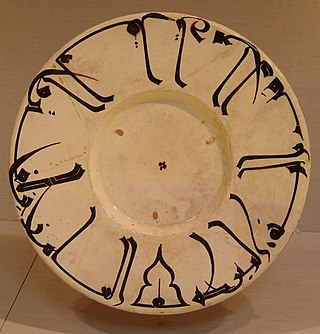
Earthenware is glazed or unglazed nonvitreous pottery that has normally been fired below 1,200 °C (2,190 °F). Basic earthenware, often called terracotta, absorbs liquids such as water. However, earthenware can be made impervious to liquids by coating it with a ceramic glaze, and such a process is used for the great majority of modern domestic earthenware. The main other important types of pottery are porcelain, bone china, and stoneware, all fired at high enough temperatures to vitrify. End applications include tableware and decorative ware such as figurines.

Stoneware is a broad term for pottery fired at a relatively high temperature. A modern definition is a vitreous or semi-vitreous ceramic made primarily from stoneware clay or non-refractory fire clay. End applications include tableware, decorative ware such as vases.

Islamic pottery occupied a geographical position between Chinese ceramics, and the pottery of the Byzantine Empire and Europe. For most of the period, it made great aesthetic achievements and influence as well, influencing Byzantium and Europe. The use of drinking and eating vessels in gold and silver, the ideal in ancient Rome and Persia as well as medieval Christian societies, is prohibited by the Hadiths, with the result that pottery and glass were used for tableware by Muslim elites, as pottery also was in China but was much rarer in Europe and Byzantium. In the same way, Islamic restrictions greatly discouraged figurative wall painting, encouraging the architectural use of schemes of decorative and often geometrically patterned titles, which are the most distinctive and original specialty of Islamic ceramics.
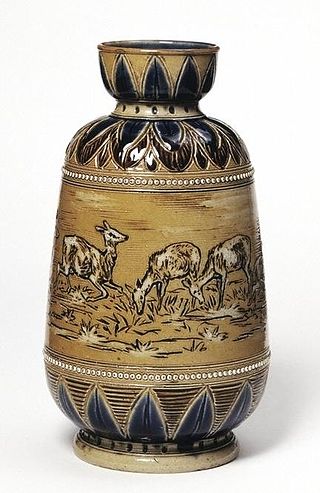
Royal Doulton is an English ceramic and home accessories manufacturer that was founded in 1815. Operating originally in Vauxhall, London, and later moving to Lambeth, in 1882 it opened a factory in Burslem, Stoke-on-Trent, in the centre of English pottery. From the start, the backbone of the business was a wide range of utilitarian wares, mostly stonewares, including storage jars, tankards and the like, and later extending to drain pipes, lavatories, water filters, electrical porcelain and other technical ceramics. From 1853 to 1901, its wares were marked Doulton & Co., then from 1901, when a royal warrant was given, Royal Doulton.

Chinese ceramics show a continuous development since pre-dynastic times and are one of the most significant forms of Chinese art and ceramics globally. The first pottery was made during the Palaeolithic era. Chinese ceramics range from construction materials such as bricks and tiles, to hand-built pottery vessels fired in bonfires or kilns, to the sophisticated Chinese porcelain wares made for the imperial court and for export. Porcelain was a Chinese invention and is so identified with China that it is still called "china" in everyday English usage.

János Horvay was a Hungarian sculptor, who earned reputation with his statues about Lajos Kossuth, leader of the Hungarian national uprising in 1848–49. However his most important work, the great Kossuth Memorial in Budapest proved to be a failure.

Mintons was a major company in Staffordshire pottery, "Europe's leading ceramic factory during the Victorian era", an independent business from 1793 to 1968. It was a leader in ceramic design, working in a number of different ceramic bodies, decorative techniques, and "a glorious pot-pourri of styles - Rococo shapes with Oriental motifs, Classical shapes with Medieval designs and Art Nouveau borders were among the many wonderful concoctions". As well as pottery vessels and sculptures, the firm was a leading manufacturer of tiles and other architectural ceramics, producing work for both the Houses of Parliament and United States Capitol.

Ceramic glaze, or simply glaze, is a glassy coating on ceramics. It is used for decoration, to ensure the item is impermeable to liquids and to minimise the adherence of pollutants.
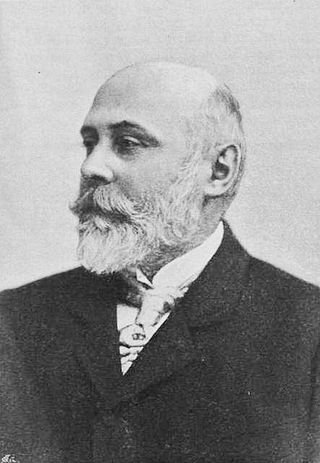
Ödön Lechner was a Hungarian architect, one of the prime representatives of the Hungarian Szecesszió style, which was related to Art Nouveau in the rest of Europe, including the Vienna Secession. He is famous for decorating his buildings with Zsolnay tile patterns inspired by old Magyar and Turkic folk art, which are combined with modern materials such as iron.
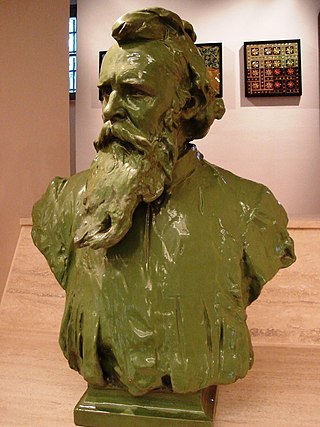
Vilmos Zsolnay was a Hungarian industrialist and entrepreneur. As the director of the Zsolnay porcelain manufacture he introduced new materials and inventions into the manufacture of pottery and ceramics and led the company to world-wide recognition.

Royal Tichelaar Makkum is a Dutch pottery company in Makkum. After initially producing bricks and later pottery and tiles, the company has focused on traditional decorative pottery since 1890. As the company in Makkum has always made ceramics, Royal Tichelaar Makkum is regarded as one of the oldest companies in the Netherlands. The Royal Tichelaar Makkum has always specialized in stoneware and earthernware, and started making porcelain from 1999. The first Dutch porcelain dates to 1759, with the advent of Weesp porcelain.

Art pottery is a term for pottery with artistic aspirations, made in relatively small quantities, mostly between about 1870 and 1930. Typically, sets of the usual tableware items are excluded from the term; instead the objects produced are mostly decorative vessels such as vases, jugs, bowls and the like which are sold singly. The term originated in the later 19th century, and is usually used only for pottery produced from that period onwards. It tends to be used for ceramics produced in factory conditions, but in relatively small quantities, using skilled workers, with at the least close supervision by a designer or some sort of artistic director. Studio pottery is a step up, supposed to be produced in even smaller quantities, with the hands-on participation of an artist-potter, who often performs all or most of the production stages. But the use of both terms can be elastic. Ceramic art is often a much wider term, covering all pottery that comes within the scope of art history, but "ceramic artist" is often used for hands-on artist potters in studio pottery.

Széchenyi Square is the main square in the historical centre of Pécs, Hungary. In the Middle Ages it served as the market place of the town with the city hall and the parish church. Before being named after Széchenyi in 1864, it had had several other names including Fórum, Városi piacz, and Főtér. The square is one of the central squares of Pécs, full of monuments, mounting gradually northward. Twelve streets lead into the square spoke-wise. Its main attractions are the Mosque of Pasha Qasim, the City Hall, the County Hall, the Nádor hotel, the Zsolnay well, the Fatebenefratelli Church, the Trinity statue and the brass statue of János Hunyadi on horse back. The surface of the square was rebuilt within the scope of the project Pécs2010 European Cultural Capital. Within the annual Pécs days festival, the festival of wine and grape is held on the square. It is celebrated fairs and vintage carnivals wine tasting of the famous wine regions of Pécs and Villány. The Christmas tree of the town is set on Széchenyi Square.

Ceramic art is art made from ceramic materials, including clay. It may take varied forms, including artistic pottery, including tableware, tiles, figurines and other sculpture. As one of the plastic arts, ceramic art is a visual art. While some ceramics are considered fine art, such as pottery or sculpture, most are considered to be decorative, industrial or applied art objects. Ceramic art can be created by one person or by a group, in a pottery or a ceramic factory with a group designing and manufacturing the artware.

Sang de boeuf glaze, or sang-de-boeuf, is a deep red colour of ceramic glaze, first appearing in Chinese porcelain at the start of the 18th century. The name is French, meaning "ox blood", and the glaze and the colour sang de boeuf are also called ox-blood or oxblood in English, in this and other contexts.

Teréz Zsolnay, married Mattyasovzky was a Hungarian applied artist in the medium of ceramics who worked for the Zsolnay Ceramic Factory, founded by her father Vilmos Zsolnay in Pécs, in 1868.
Julia Zsolnay, married Sikorski was a Hungarian applied artist and painter in the medium of ceramics who worked for the Zsolnay Ceramic Factory, founded by her father Vilmos in Pécs, in 1868. Along with her older sister Teréz and Ármin Klein, she was the most productive and most important artist of that factory during its rapid development and worldwide success in the late 19th and early 20th centuries.
